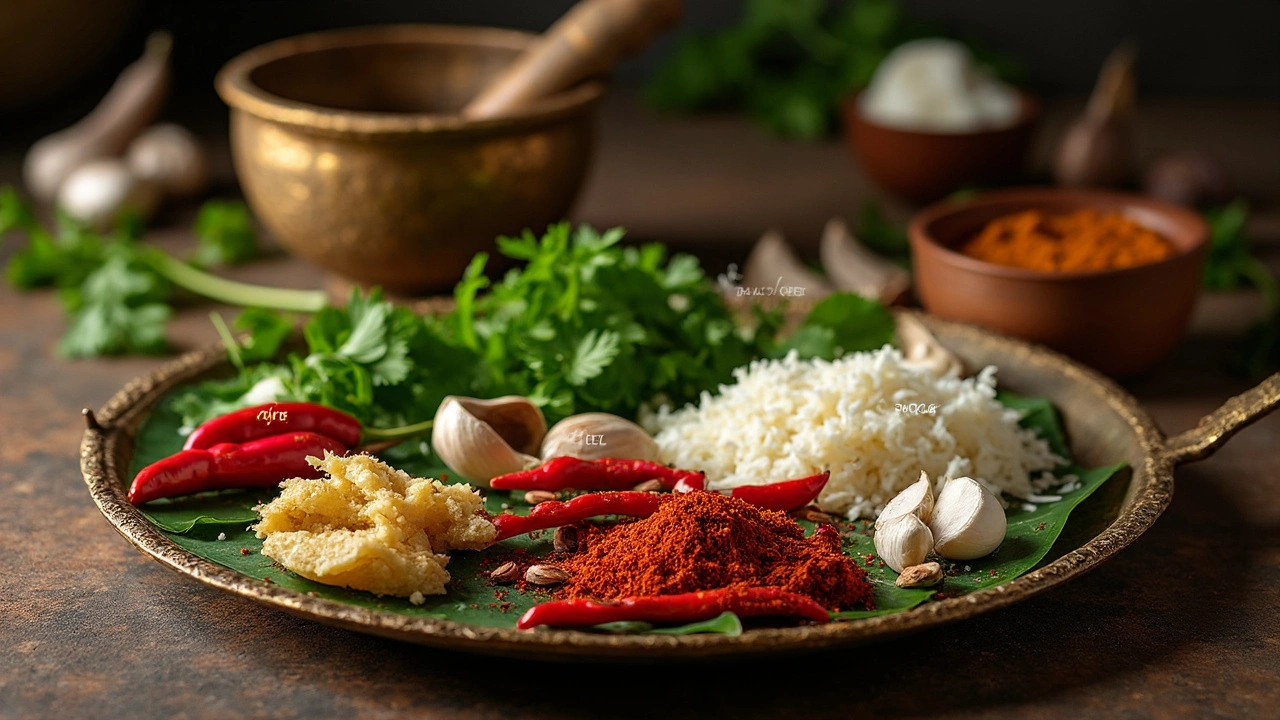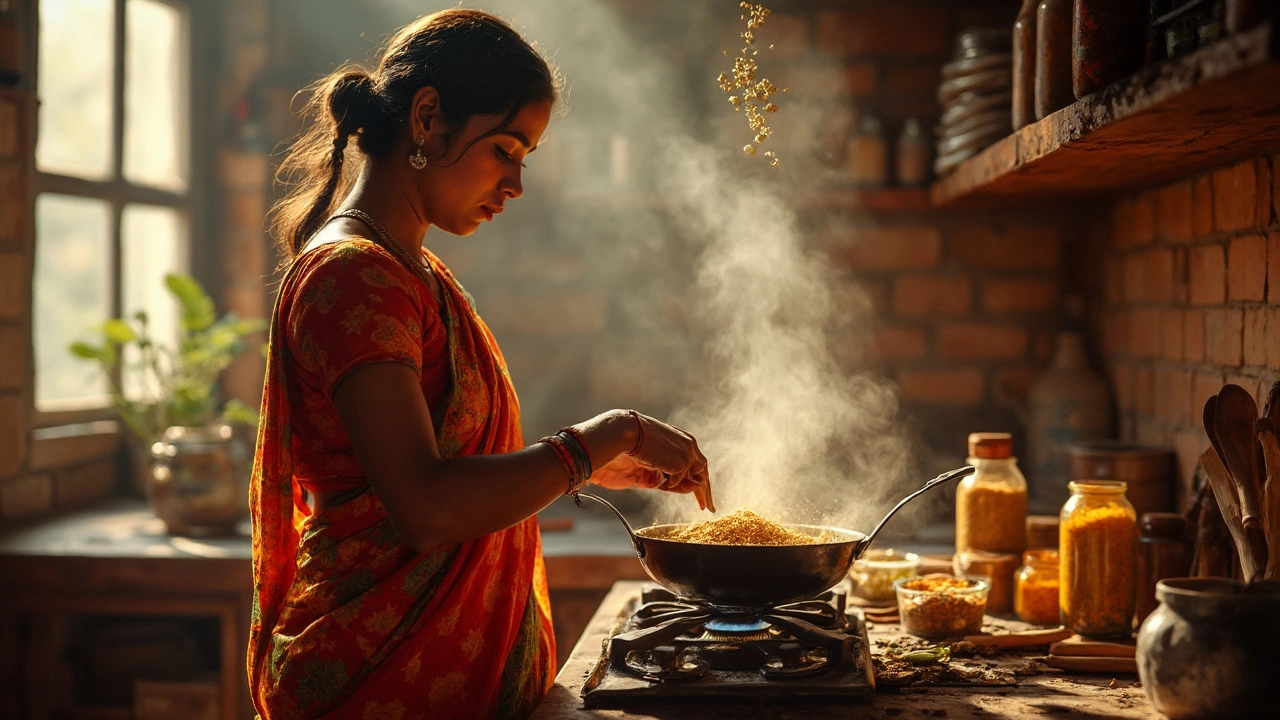If you've ever stood over a simmering pot, hoping your curry would taste like memories of that unforgettable restaurant dish, you've probably asked yourself: why does mine taste like all the parts, but theirs tastes like a story? It all comes down to depth. Not just heat or salt or a blur of strong flavors thrown together—real depth in curry creeps up slowly, blends and builds, and lingers after the last bite. There's a reason some people would rather eat last night's curry leftovers than what's just off the stove: depth gets better with time, but it's not just about patience—it's about the moves you make right from the start.
How Depth Happens: Layers from the Ground Up
Depth in curry is about how flavors unfold, with each spoonful revealing something new. This is the kind of meal that makes you pause to guess what spice just popped or why you can't stop eating. Most home cooks think the secret is the sort of spice blend you buy, maybe from an Asian supermarket shelf. Sure, good spices matter. But depth comes from layering every flavor, texture, and aroma with intention. Let's break it down concretely—this isn't chef show-off stuff, this is what changes an ordinary curry into something you think about for days.
Start with the base: onions, garlic, ginger. So classic, so easy to breeze past. But the way you cook them matters. Caramelize onions on low and slow until they're deep gold and jammy. Don't let impatience steal that sweetness from you—a rush job gives only bite, not body. Try this: for each large onion, think 15–20 minutes, stirring here and there, letting the sugars do their thing. Caramelizing onions forms the backbone, giving the entire curry a rich foundation that can't be faked with powders. Only after you've nailed this do you add grated fresh ginger and garlic. Ginger gives sharp brightness, garlic builds earthy warmth, but overcooked garlic turns bitter so toss it in after the onions are done.
Then come the spices. Whole ones—cumin seeds, coriander seeds, mustard seeds—should hit hot oil first. This is called tempering. The oil pulls fragrance and flavor from the spices in seconds, transforming the mood of your kitchen. There's science here: spices are packed with essential oils that stay trapped in their shells until heat and oil make them sing. If you want to get real, use a pestle and mortar to barely crack whole seeds before tempering, releasing those oils faster and making every bite impossibly aromatic.
The next layer is the ground spices: turmeric, chili, garam masala, maybe fenugreek or ground clove. Add them once your base is ready—if you sprinkle them straight into raw oil, they burn; if you add too late, they don't have time to bloom. Fry these for just 30–60 seconds, stirring with purpose. If you look closely, the curry sauce will darken and thicken slightly—this is the base for deep flavor. And here's a tip straight from my own Auckland kitchen: don’t be afraid to switch out some of the chili powder for smoked paprika if you want warmth without too much heat. Luna, my golden retriever, once ate a dropped chili. Lesson learned: hold back the fire for sensitive tongues.
Acidity is next. Tomatoes bring sourness, a bright contrast to the deeper, roasted notes. Some curries get their lift from tamarind paste, dried mango powder (amchur), or just a squeeze of lime at the end. Tomatoes also help ground spices dissolve into the sauce, adding complexity. If the tomatoes are too tart, I like to caramelize a bit of tomato paste in the pan until the color deepens to brick—this banishes any raw edge and concentrates umami like magic.
Fat might sound like a dirty word, but the right fats carry flavors deep into the sauce. Ghee, coconut oil, or even a swirl of heavy cream at the end does more than make the dish rich. These fats bind spices to each other, coat your palate, and give curries their silky mouthfeel. There’s actual food science behind this: certain flavor molecules in spices only dissolve in fat—without enough, the flavor just sits on top rather than getting woven in. Classic South Indian curries lean on coconut milk (that's the secret to why the leftovers are even better), while North Indian gravies often finish with ghee or cream. Don’t skip the fat, even if you’re cutting down. Try substituting half coconut milk, half water, for creaminess with fewer calories—the texture still hugs every mouthful.
Balance matters. Curries shine when they nail salty, sour, spicy, and sweet all at once. Here’s a personal trick: if your curry feels flat, add the tiniest pinch of sugar or honey—sometimes it’s the missing piece. If it’s too sweet or cloying, a dash of lemon juice, vinegar, or chopped coriander stems (not just leaves) can snap it back into shape.
Fresh herbs like coriander, mint, or fenugreek leaves don’t just look pretty. Scatter some over the finished dish, and you’ll taste brightness against the heavy, rich sauce. In my house, Luna usually tries to sneak some coriander from the kitchen counter, but I’m watching—dogs and strong herbs don’t mix too well.
Wondering if your layering really works? Try tasting your curry at different stages: before the onions caramelize, after you fry the spices, when you add the tomatoes, and again at the finish. Each layer should taste noticeably deeper, more complex. Don’t rush the simmer, either. Ten extra minutes can feel like a long time, but that’s when all the layers settle into each other. The longer you wait (even overnight in the fridge), the more unified and deep the flavor gets.
Here’s a table with a quick summary to help you identify which layer does what in your curry:
| Curry Component | Main Contribution to Depth | Special Tips |
|---|---|---|
| Caramelized Onion | Sweetness, Body | Patience pays—don’t burn, just slow cook |
| Fresh Ginger, Garlic | Pungency, Sharpness | Grate fine for best flavor, add after onions |
| Whole Spices | Aromatic Lift, Complexity | Crack before tempering for more aroma |
| Roasted Ground Spices | Warmth, Color, Depth | Fry briefly—too long and they go bitter |
| Acids (Tomatoes, Tamarind) | Brightness, Balance | Add during simmer, adjust at end if needed |
| Fats/Oils | Mouthfeel, Flavor Carrier | Finish with ghee or coconut cream for silkiness |

Unlocking Extra Flavor: Tricks Beyond Recipes
Curry isn’t just about ingredients—it’s about the little decisions you make. Let’s talk kitchen tricks, because no two cooks do it quite the same. One wildly effective tip: toast and grind your own spices. It’s one of those changes that takes three minutes but makes your curry taste ten times more complex. Ready-made ground spices lose punch after a few weeks; fresh ones, toasted in a dry skillet and blitzed in a coffee grinder, will make your kitchen smell like an Indian spice bazaar.
Don’t forget the "secret ingredient" angle. Many cooks swear by a spoonful of nut butter (peanut, almond, or cashew) stirred in right at the end. It’s a rare move outside of southeast Asian curries, but it gives surprising body and a luxurious mouthfeel. In West Africa, groundnut stew (peanut curry) is a staple—there’s a reason why. A dollop of yogurt or even sour cream off the heat adds tang and rounds out the harshest edges.
Wine in curry? Sounds odd, but a splash of white wine into a tomato-based curry lifts fruit flavors and adds subtle acid just before you add meat or veggies. Just don’t pour in a ton—two tablespoons per pot is enough. In my kitchen, I usually keep it classic, but when I make a South Asian–inspired seafood curry, a little dry riesling makes the whole dish bloom.
Texture counts as much as taste. Add some root veggies (sweet potato, pumpkin, carrot) which, when cooked down, thicken the sauce naturally and give a warming depth. I toss in cubes of potato and a handful of frozen peas for sweetness and a pop of color—a trick my mum taught me when I was a kid and too picky to eat anything green unless it looked cute.
If you’re not vegetarian, searing your protein first brings major benefits. The Maillard reaction—the one that creates those yummy brown bits—locks in flavor. Chicken, lamb, even tofu can all benefit. Remove them after browning, prepare your curry base, and add them back later. This layering keeps you from boiling away those savory notes. Always season meats before you brown them, and use those brown bits (fond) stuck to the pan for depth—pour a little stock or water to deglaze and scrape them in.
If sauces get too thick or intense, don’t dilute with water. Try coconut milk, stock (chicken or veggie), or even a bit of reserved pasta cooking water, which carries starch and body. Thin sauces leave curries tasting flat, but starchy liquids keep everything rich without overpowering your carefully built flavors.
Here's a weird Auckland trick: try a hint of dark soy or Worcestershire sauce, especially if your curry feels a little anemic. You only need a few drops—it carries salt, umami, and a rounded depth that can rescue a flat-tasting sauce. If you want to go hyper-local, add a teaspoon of New Zealand mānuka honey instead of sugar. It adds a deep sweetness and a subtle herbal essence—unexpected, but it works wonders.
Curry purists may raise their eyebrows at these little hacks, but food is about pleasure, creativity, and making what you love. If you experiment and find something that multiplies the depth, don’t let a recipe stop you. The trick is keeping balance in mind so nothing overpowers the base.

The Long Game: Patient Simmering and the Secret Power of Time
If you’ve ever noticed how last night’s curry tastes way better today, it’s not imagination. There’s science behind it: flavors mingle, meld, and mellow as proteins break down and sugars convert. A 2018 study from the University of Reading found that curries left to rest for 24 hours showed marked increases in certain flavor compounds, making them taste more unified and complex. Seriously, some chefs call this “overnight magic.”
During cooking, spices release both fat-soluble and water-soluble oils. When allowed to rest, these oils disperse more evenly, forming new compounds and unlocking flavors that aren’t there the first time you taste. It’s like letting soup chill in the fridge—everything gets friendlier and more nuanced. If you’re impatient, a simple trick is to finish the curry and let it simmer, covered, on the lowest heat for 30 minutes longer than you think you need. Just be sure to stir often and check that it’s not sticking; burnt curry is a heartbreak that even Luna can’t fix (though she’ll try to eat the evidence off the floor).
The pot you cook in matters too. Stainless steel, enamel, or thick-bottomed pans help you keep an even heat, preventing scorching and allowing those flavors to gradually deepen. Thin pots let the sauce overcook in spots, making it bitter. It sounds nerdy, but if you’re serious about depth, cookware isn’t just a vanity buy—it’s an ingredient in its own right.
Keep seasonings fluid. After a long simmer, the flavors you built at the start might mute a little. Taste and tweak: add a squeeze of lemon, a pinch of salt, or a swirl of yogurt to wake it up. Taste again. Flavor is about adjusting at every step, not just following a recipe to the letter.
Putting a lid on depth in curry, it’s this: patience and small choices stack up in every mouthful, turning good curry into one that haunts you for weeks. Take your time, use your senses, and don’t be afraid to try something new. Even Luna knows—when the kitchen smells right, dinner’s almost ready, and it’ll be something to remember.
